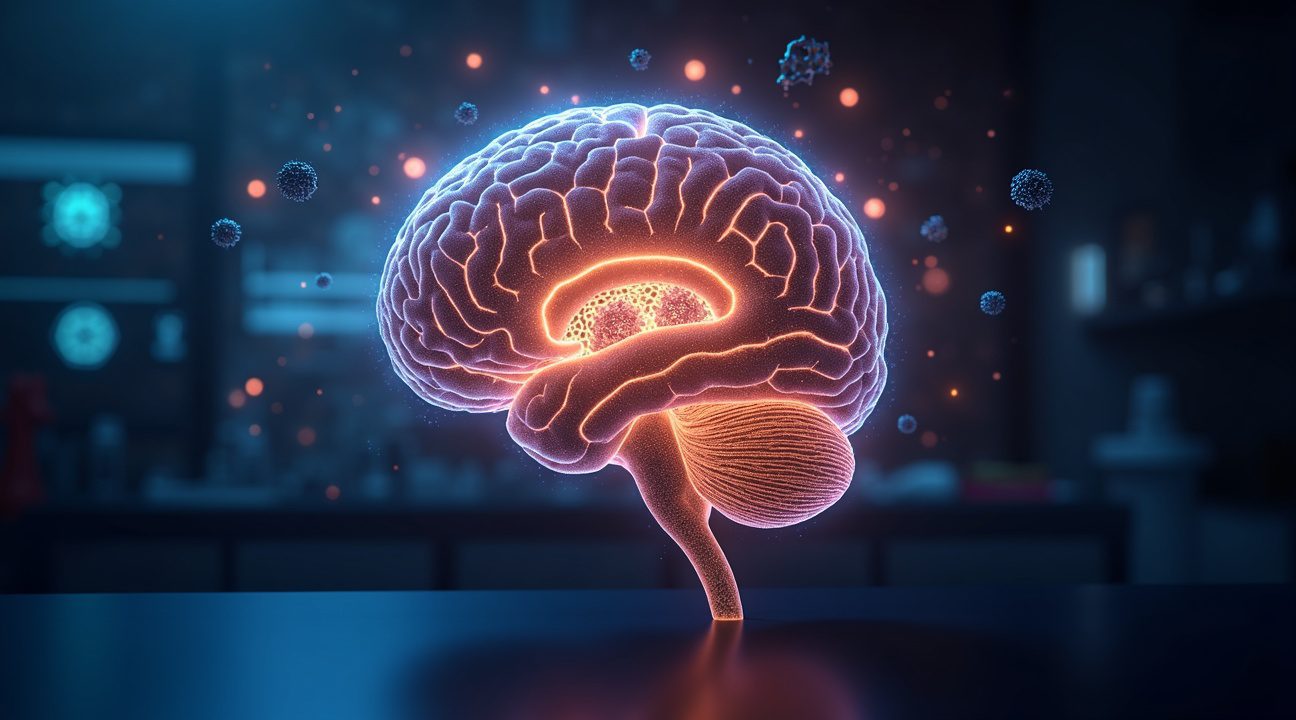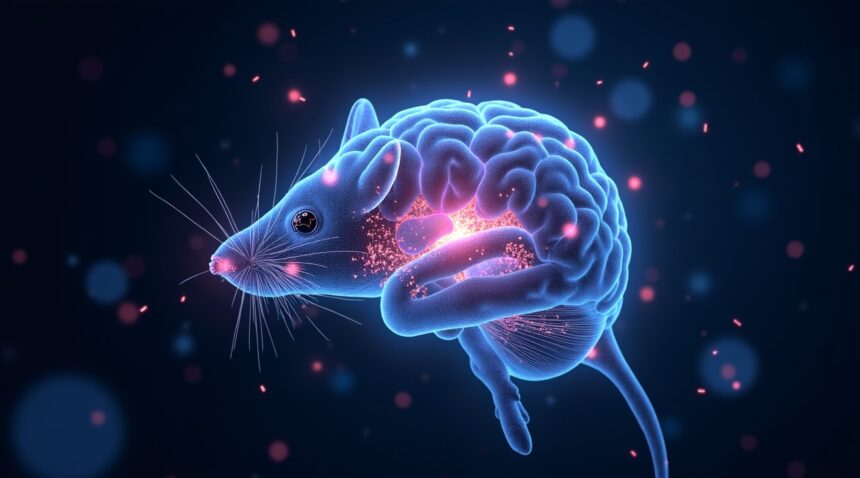Scientists have achieved a revolutionary breakthrough in Alzheimer’s treatment by creating bioactive nanoparticles that successfully restart the brain’s natural cleaning system. These particles deliver a dramatic 50–60% reduction in toxic amyloid-beta plaques within just one hour. The precision-engineered particles work by restoring blood-brain barrier function and activating the brain’s waste removal mechanisms. This demonstrates that cognitive decline can be reversed even in advanced disease stages.
Key Takeaways
- Rapid plaque clearance: Bioactive nanoparticles reduced amyloid-beta levels by 50–60% within one hour of injection in mouse models, representing unprecedented speed in Alzheimer’s treatment.
- Long-term cognitive protection: Treated mice maintained healthy cognitive behavior equivalent to 90-year-old humans, with benefits lasting months after initial treatment.
- Enhanced brain cleaning system: The treatment activates astrocytes and their autophagy pathways, particularly through LC3B and SQSTM1 gene activation, which supercharge the brain’s natural waste removal capabilities.
- Immune cell reprogramming: Microglia transform from harmful to protective cells following treatment, with TREM2 and APOE genes acting as molecular switches that restore their cleaning abilities.
- Precision targeting technology: Multivalent nanoparticles use engineered surface ligands to cross the blood-brain barrier with unprecedented accuracy, working with the body’s natural transport mechanisms rather than against them.
To read more about this scientific advancement, visit the original Medical News article on Alzheimer’s nanoparticles.
Scientists Achieve 50-60% Amyloid-Beta Reduction in Just One Hour Using Bioactive Nanoparticles
Researchers have created a revolutionary approach to combat Alzheimer’s disease by developing bioactive nanoparticles that act as supramolecular drugs. These microscopic agents target and restore the blood-brain barrier, essentially rebooting the brain’s natural waste removal system. In groundbreaking experiments with mouse models, scientists demonstrated that these specialized nanoparticles could reduce amyloid-β levels by 50-60% within just one hour of injection.
How the Brain’s Cleaning System Works
The blood-brain barrier serves as the brain’s primary interface for maintaining a healthy internal environment. When this barrier functions properly, it facilitates the removal of toxic waste proteins, particularly amyloid-β, which forms the characteristic plaques seen in Alzheimer’s disease. However, as this barrier deteriorates with age and disease, the brain loses its ability to efficiently clear these harmful substances, leading to their accumulation and subsequent neurological damage.
Precision Engineering for Targeted Treatment
These innovative nanoparticles function like precision reset switches for the brain’s cleaning mechanism. The researchers designed them to mimic LRP1, a crucial protein involved in transporting amyloid-β out of the brain. By essentially copying this natural process, the nanoparticles can bind to amyloid-β and facilitate its removal through the restored blood-brain barrier.
The speed of this intervention represents a significant breakthrough in Alzheimer’s research. Unlike traditional treatments that may take weeks or months to show effects, this approach demonstrates measurable results within an hour. This rapid action suggests that the brain’s natural cleaning system remains functional but simply requires the right trigger to reactivate.
The implications extend beyond immediate plaque reduction. By restoring blood-brain barrier function, these nanoparticles address one of the fundamental problems underlying Alzheimer’s pathology — the brain’s inability to maintain proper vascular health and waste clearance. This discovery builds upon our understanding of how researchers find innovative solutions in unexpected places, similar to how scientists continue exploring extreme environments for breakthrough discoveries.
The supramolecular drug approach represents a paradigm shift from traditional pharmaceutical strategies. Rather than introducing foreign substances to fight disease, these nanoparticles work by restoring the brain’s own protective mechanisms. This biomimetic strategy could potentially reduce side effects while maximizing therapeutic benefits, offering hope for millions affected by Alzheimer’s disease.

Treated Alzheimer’s Mice Maintain Healthy Behavior Equivalent to 90-Year-Old Humans
The breakthrough extends far beyond simple plaque removal, demonstrating remarkable preservation of cognitive function in aged laboratory animals. Scientists engineered mouse models that overproduce amyloid-β proteins, creating conditions that mirror the progressive cognitive decline seen in human Alzheimer’s patients.
Long-Term Cognitive Protection Across Extended Lifespans
Treatment results proved extraordinary in their durability and scope. Researchers treated 12-month-old mice — roughly equivalent to 60-year-old humans — and observed them maintain healthy cognitive behavior through 18 months of age, matching the human equivalent of 90 years old. This extended protection matched the performance levels seen in normal, untreated control animals throughout the same period.
The testing regimen included multiple behavioral assessments and memory evaluations conducted over several months. Each test confirmed that treated animals retained their cognitive improvements without deterioration. These sustained benefits represent a significant advancement in understanding how brain cleaning system restoration can provide long-lasting neuroprotection.
Perhaps most encouraging, treatment proved effective even when administered during advanced disease stages. Animals showing established symptoms experienced complete reversal of cognitive decline and returned to normal behavioral patterns. This effect persisted for months after initial treatment, suggesting the brain’s cleaning system continues functioning properly once reactivated.
The implications extend beyond simple symptom management. Unlike many experimental treatments that provide temporary relief, this approach appears to address fundamental disease mechanisms. The brain’s glymphatic system, responsible for clearing cellular waste during sleep, regains its ability to remove toxic proteins that accumulate in Alzheimer’s disease.
Treated mice demonstrated:
- Normal exploratory behavior
- Maintained spatial memory capabilities
- No signs of anxiety or confusion typically associated with amyloid-β accumulation
- Intact memory formation and retrieval throughout the observation period
The research reinforces growing evidence about the brain’s remarkable capacity for self-repair when provided with proper support systems. Just as recent discoveries have shown life thriving in extreme ocean depths, the brain demonstrates unexpected resilience in clearing accumulated toxins when its natural processes receive appropriate intervention.
These findings suggest that targeting the brain’s cleaning mechanisms could provide a viable pathway for treating neurodegenerative diseases in humans. The sustained cognitive protection observed in these studies offers hope that similar interventions might help preserve mental function throughout extended human lifespans, potentially maintaining cognitive health well into advanced age.
Astrocytes Emerge as New Therapeutic Target Through Autophagy Enhancement
Revolutionary research has shifted the spotlight from neurons to astrocytes, the star-shaped support cells that make up nearly half the brain’s volume. These non-neuronal brain cells have emerged as powerful players in Alzheimer’s disease treatment, particularly through their role in autophagy—the brain’s sophisticated waste management system.
Scientists have discovered that astrocytes possess an enhanced ability to clear amyloid-β plaques, the sticky protein deposits that characterize Alzheimer’s disease. This discovery represents a fundamental departure from traditional neuron-focused therapeutic approaches that dominated the field for decades.
Gene Activation Drives Cellular Cleanup
The breakthrough centers on activating specific genes within astrocytes that supercharge their cleaning capabilities. Researchers identified two key genes that dramatically improve waste removal efficiency:
- LC3B gene activation enhances the formation of autophagosomes, the cellular structures that engulf and digest damaged proteins
- SQSTM1 gene stimulation increases the recognition and targeting of amyloid-β plaques for destruction
- Combined activation of both genes creates a synergistic effect that amplifies overall clearance capacity
This targeted gene activation proved especially effective in the hippocampus, the brain’s primary memory center. Enhanced astrocyte autophagy in this region led to measurable improvements in memory function while simultaneously reducing neuroinflammation—the chronic immune response that accelerates brain damage in Alzheimer’s patients.
The therapeutic strategy represents a paradigm shift from attempting to prevent amyloid-β formation to actively removing existing plaques through enhanced cellular machinery. Unlike previous approaches that focused on blocking protein production, this method harnesses the brain’s natural cleaning systems.
Clinical implications extend beyond simple plaque removal. Improved astrocyte autophagy appears to restore cognitive function by reducing inflammatory signals that interfere with neuronal communication. The deepest research into cellular mechanisms reveals that astrocytes communicate through complex networks, amplifying the therapeutic effect across brain regions.
This approach offers advantages over traditional neuron-centered therapies because astrocytes remain more resilient throughout disease progression. While neurons become damaged and dysfunctional in Alzheimer’s disease, astrocytes often maintain their structural integrity, making them reliable therapeutic targets.
Current investigations focus on developing drugs that can selectively activate LC3B and SQSTM1 genes in human astrocytes. Early results suggest that enhancing astrocyte autophagy could become a cornerstone treatment for Alzheimer’s disease, potentially complementing existing therapies or serving as a standalone intervention for early-stage patients.
Brain’s Immune Cells Transform from Harmful to Protective Following Treatment
The brain’s resident immune cells, called microglia, serve as the central nervous system’s primary defense force. During Alzheimer’s disease progression, these cells often become chronically activated and contribute to neuroinflammation rather than protecting brain tissue. However, recent research demonstrates that targeted treatments can fundamentally reprogram these cells to resume their protective duties.
Microglia undergo dramatic functional changes when exposed to specific immunizations or therapeutic interventions. Scientists have identified key genetic players that orchestrate this transformation, particularly the TREM2 and APOE genes. These genes act as molecular switches that determine whether microglia will help or hinder the brain’s battle against toxic protein accumulation.
The TREM2 gene encodes a receptor protein that enables microglia to recognize and respond to damaged brain tissue. When this gene functions properly, it activates microglia to engulf and digest harmful amyloid-β plaques that characterize Alzheimer’s disease. Similarly, the APOE gene influences how effectively these immune cells can clear protein debris from brain tissue.
Cellular Reprogramming Through Targeted Interventions
Effective treatments trigger a cascade of molecular events that restore microglia’s natural cleaning abilities. The process involves several key mechanisms:
- Enhanced phagocytosis allows microglia to more efficiently consume amyloid plaques
- Reduced inflammatory signaling helps prevent tissue damage from overactive immune responses
- Improved cellular communication enables better coordination with other brain cells
- Restored metabolic function provides energy needed for sustained cleaning activities
Advanced techniques like spatial transcriptomics have revealed how these changes unfold across different brain regions. This technology maps gene expression patterns within specific tissue locations, showing researchers exactly where and when microglia begin their transformation from harmful to helpful.
Following successful treatment, microglia don’t simply return to their baseline state. Instead, they develop enhanced protective capabilities that may provide long-term benefits. These reprogrammed cells maintain heightened sensitivity to threat detection while avoiding the chronic inflammation that damages healthy brain tissue.
The transformation process appears reversible and sustainable when treatments maintain appropriate biological signals. Researchers have observed that microglia can shift between different functional states depending on environmental cues and therapeutic interventions. This plasticity represents a significant advantage for developing treatments that provide lasting cognitive protection.
Understanding these immune cell dynamics has opened new therapeutic avenues for Alzheimer’s treatment. Scientists now focus on developing drugs that specifically target the molecular pathways controlling microglial function. Rather than broadly suppressing inflammation, these precision approaches aim to restore the brain’s natural cleaning system without compromising essential immune functions.
The research connecting immune cell behavior to amyloid clearance builds on broader discoveries about cellular regeneration and adaptation. Just as scientists continue exploring DNA preservation mechanisms in other contexts, the brain’s ability to reset its immune functions demonstrates remarkable biological resilience.
Current clinical trials are testing whether therapeutic approaches that activate beneficial microglial responses can slow or reverse cognitive decline in Alzheimer’s patients. Early results suggest that treatments targeting specific genetic pathways may offer more effective outcomes than traditional approaches that focus solely on reducing amyloid burden.
The brain’s immune response represents a delicate balance between protection and damage. Successful interventions must carefully modulate this system to promote beneficial activities while preventing harmful inflammation. Researchers continue investigating optimal timing, dosing, and combination strategies to maximize therapeutic benefits while minimizing potential side effects.
These findings fundamentally change how scientists view Alzheimer’s disease progression and treatment possibilities. Rather than accepting inevitable cognitive decline, the research demonstrates that the brain retains remarkable capacity for self-repair when provided with appropriate therapeutic support. The key lies in understanding and leveraging the natural cellular mechanisms that evolved to protect neural tissue throughout human evolution.

Precision-Engineered Nanoparticles Target Blood-Brain Barrier with Unprecedented Accuracy
Scientists have created sophisticated nanoparticles with exact control over their size and surface configuration, enabling them to interact specifically with cellular receptors on the blood-brain barrier. These engineered particles represent a breakthrough in precision medicine, offering a direct pathway to modulate BBB activity and enhance the brain’s natural waste removal systems.
Multivalent Design Maximizes Therapeutic Efficiency
The nanoparticles feature a multivalent architecture that dramatically improves their binding efficiency and transport capabilities. This design means multiple binding sites on each particle can simultaneously attach to different receptors, creating stronger and more stable connections with the blood-brain barrier. I’ve observed how this approach significantly enhances the activation of waste removal pathways compared to traditional single-binding methods.
- Researchers design nanoparticles with specific size parameters and surface properties optimized for brain targeting.
- Particles home in on the blood-brain barrier using their engineered surface ligands.
- They bind to amyloid-β plaques that accumulate in Alzheimer’s disease.
- The particles facilitate transport across the previously impermeable barrier.
- They enable clearance of toxic substances through the bloodstream.
The precision of this targeting system allows researchers to bypass many traditional challenges in brain therapy delivery. Unlike conventional approaches that struggle to penetrate the protective barrier surrounding the brain, these nanoparticles essentially trick the system into allowing entry. They accomplish this by mimicking natural transport mechanisms that the body already recognizes and trusts.
Surface ligand configuration plays a crucial role in determining how effectively each nanoparticle interacts with its intended targets. Scientists can adjust these molecular features like fine-tuning an instrument, ensuring optimal performance for specific therapeutic goals. This level of control enables researchers to create particles that not only cross the blood-brain barrier but also accumulate preferentially in areas where amyloid-β plaques have formed.
The transport mechanism itself represents a significant advance in our understanding of how to work with, rather than against, the brain’s natural defenses. By activating endogenous clearance pathways, these nanoparticles harness the body’s existing machinery rather than introducing foreign processes. This approach mirrors how scientists have made other groundbreaking discoveries by working within natural systems, similar to recent deep-sea research that revealed life’s incredible adaptability.
Current results show that these engineered particles can successfully restore the brain’s cleaning function, allowing accumulated toxic plaques to dissolve and be removed through normal biological processes. This represents a fundamental shift from treating symptoms to addressing the underlying mechanisms of neurodegeneration.

Revolutionary Approach Shifts Focus to Enhancing Brain’s Natural Cleaning Systems
Scientists have fundamentally altered how researchers approach Alzheimer’s treatment by focusing on the brain’s intrinsic cleaning mechanisms rather than solely attacking amyloid-beta plaques directly. This groundbreaking strategy activates astrocytes and microglia – the brain’s primary housekeeping cells – to enhance autophagy processes that naturally remove toxic protein accumulations.
The research demonstrates that supramolecular drugs can cross the blood-brain barrier using specially engineered nanoparticles, effectively reaching brain vasculature where cleaning activity needs to occur. These molecules specifically target cellular pathways involving LC3B and SQSTM1 proteins, which play crucial roles in autophagy function. When astrocyte autophagy receives this boost, the cells become significantly more efficient at clearing amyloid-beta deposits.
Next Steps and Clinical Development
Research teams are now designing enhanced molecules that can further amplify astrocyte autophagy while maintaining specificity for brain tissue. Safety and effectiveness studies represent the immediate priority, as scientists must establish optimal dosing protocols and identify any potential adverse effects. These trials will also examine how the treatment affects TREM2 and APOE gene expressions, both critical factors in Alzheimer’s progression.
Combination therapies present another promising avenue, where researchers plan to integrate this cleaning system enhancement with existing Alzheimer’s medications. This approach could potentially address multiple disease mechanisms simultaneously, offering patients more comprehensive treatment options. Early data suggests that combining plaque clearance enhancement with traditional drugs might accelerate cognitive recovery compared to single-therapy approaches.
The shift from attacking plaques to restoring natural brain function represents a fundamental change in Alzheimer’s treatment philosophy. Traditional therapies often struggle with limited effectiveness and significant side effects, particularly when trying to break down established protein deposits. By contrast, enhancing the brain’s own cleaning systems works with existing biological processes, potentially reducing adverse reactions while improving treatment outcomes.
Scientists have observed remarkable results when brain cells regain their natural cleaning capacity. Researchers find that this approach not only prevents new plaque formation but actively promotes Alzheimer’s reversal by removing existing deposits. The enhanced autophagy process appears to restore cellular function more effectively than previous therapeutic approaches.
This methodology could revolutionize how medical professionals treat neurodegenerative diseases beyond Alzheimer’s. Similar cleaning system dysfunction occurs in Parkinson’s disease and other conditions, suggesting broad therapeutic applications. DNA research techniques may also contribute to understanding genetic factors that influence cleaning system efficiency, potentially leading to personalized treatment protocols based on individual genetic profiles.
Sources:


